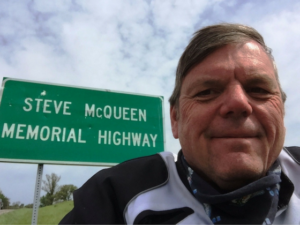We first met Jim and learned his story when he signed up to participate in a virtual patient panel. If you’re interested in sharing your story and hearing about opportunities like the one Jim had, sign up to share your story.
“This is not a pretend disease.”
It’s a phrase Jim Weatherhead has used often over the last 30 years of his life. He’s talking about ankylosing spondylitis (AS), a form of arthritis that primarily affects the spine. It causes inflammation of the spinal joints (vertebrae) that can lead to severe, chronic pain and discomfort. “We’re not talking just a little pain,” he explains. “It started in my hips like ice picks and later like daggers between my vertebrae. Some days I could walk it off, some days I couldn’t even get out of bed.”
Jim first began experiencing pain in his hips at age 17 that led him to seek medical help (this was in the mid-1970’s). By the early 1980’s, Jim was suffering from severe lower back pain which became progressively worse over the next couple of decades.
“It was crazy because I was in great shape,” he says. “I looked like your prototypical football running back. The doctors I saw had such a hard time coming to terms with how much pain I was in because of the way I looked. One of them finally picked up on something and sent me to a rheumatologist in 1984 which led to my diagnosis age 26.”
Anyone who has suffered from a seemingly “invisible illness” like AS can tell you how fortunate it is to find a medical provider who picks up on the subtle clues about what’s really going on, especially 20 or 30 years ago.



Jim’s x-rays from a year ago, which look MUCH better
“She was able to diagnose me right away, just by looking at my x-rays and blood tests,” Jim recalls.
“She said I was a textbook case of ankylosing spondylitis.
I got a glimpse of the radiographic scan by peeking around the curtain. Starting at my pelvis it was just glowing all the way up my spine – I looked like a Christmas tree.”
Getting a diagnosis was a step in the right direction, but it didn’t mean Jim would find immediate relief from his symptoms. Despite making dramatic changes in his diet and trying a number of prescription medications, the pain and stiffness eventually got so bad that he had to give up one of his favorite activities: competitive motorcycle racing.
While the symptoms of ankylosing spondylitis were excruciating, the feelings of isolation were even worse.
“The only other person I knew with AS was my mother so I just felt tremendously alone. By the time I was in my 30s, I felt so alone and hopeless that I was on the verge of suicide,” he says. In the depths of despair, Jim had a consultation with a young rheumatologist who talked about medical breakthroughs that were showing great promise. This helped Jim find hope and stay engaged in life, striving for a better future.



Jim began writing about what he had been through, which turned out to be an incredibly therapeutic experience and helped him connect with others when his story was published on a spondylitis awareness website called “Hope and Apples.”
“I wrote the article on my birthday,” he explains. “I woke up that morning thinking about how I wanted to share and track all of the things I’ve tried and so I started writing stuff down and it kind of morphed into the story. I think I was most motivated by wanting to show people that there is hope.”
He continues: “It was almost like a traditional grief journey for me: you start out in denial, then depression, then anger, and you have to get to the point of acceptance before you can really begin to address it, find some hope, and maybe even success at treating it.”
“There was a little bit of ego involved,” he admits. “I wanted to say ‘hey, I survived this, I learned to live again. You can too.'”
If Jim’s goal was to help others, he succeeded. After his post was published, Jim received several private messages on Facebook telling him that “it was inspirational,” or “I read that right when I needed to see some hope.”
Finding Ankylosing Spondylitis Treatment That Works
The turning point was in 2001, when his rheumatologist recommended he start taking a biologic medication called Remicade. For Jim, this was the first treatment that helped him successfully manage his inflammatory symptoms.



Jim also shared his experiences through the Spondylitis Association of America’s magazine, Spondylitis Plus, in an article titled “My Surreal and Deeply Emotional Day – Jim’s Story.”
“It was most surreal day at work,” he recalls. “I was going to meet with some new people. As I walked into the building, I realized that their office is in the same building as the doctor that I first saw to start treating my AS. There I was back in the same (now repurposed) office, 30 years later, and I had come so far.”
Jim continues to speak out about his experiences to inspire others who are facing this disease.
“Treat AS aggressively and never take a day off,” he says. “There are days you need to rest, but don’t rest because you can – rest because you must. This is one disease where you have to keep moving. If I’m not active for even a couple of days, I really notice a difference.”
[tweet_box design=”default”]”Treat AS aggressively and never take a day off” – Jim Weatherhead, #AnkylosingSpondylitis[/tweet_box]
Jim also encourages people to focus their efforts on treating the source of their symptoms, not the symptoms themselves.
“Don’t rely too much on narcotic pain medication,” he cautions. “It’s easy to get caught up in that and can lead to problems. You can build up such a tolerance and then be cut off at some point – then you’re really in trouble as your pain threshold may become compromised. There are medications out there that can treat the disease itself and when you stop or slow the disease activity you can stop or greatly reduce the pain. Focus treatment on the inflammation, not the pain.”


Awesome, awesome, awesome! There is always hope. I have a three day rule – no matter how I’m feeling, I am up and moving on the third day! Even if that means talking a walk to the mailbox. The more you lay around, the worse you feel however you do need to listen to your body and rest. Thank you for this amazing article ❤️
Love that 3-day rule, Shannon. I’m sure your mail carrier appreciates it too 🙂
I’m just getting over a week flair up
This time it was my right wrist and thumb and both my knees, upper/lower back heels and left toe joint. I honestly had the hardest time yet! 3 day rule is great tho
Thank you for advise.
So many do not understand this desease I even feel like I’m loosing it and am I crazy!!! No im not this pain is very real! Myself my twin sister and my mom we all hav AS so at least we understand each other
As much as we can. Well we can complain togeather and let off some steam.
Hi Lisa….I also suffer from AS….I was diagnosed by my rheumatologist in 2004.
In 2019 of April I felt slight stiffness in my knee..
Not knowing at the time why..
I consulted my GO but at the same time I had a stomach bug virus which was on and off for two weeks……The GO have me anti biotic and cortisone tables as he said there were crystals in my knee as he could feel them..
He said that the cortisone would dissolve the crystals who h was caused by the stomach bug as some viruses send crystals into the joints and causes pain and inflammation…
He have me other pills too ease the inflammation….
As a week or so passed it helped slightly but I was not happy….So my GP said to me I should go too a government hospital for tests blood tests by this time I was walking worse ..My bowel movements were runny I went too the restroom 6 times every hour I felt I’ll. THE pain was in my right knee and tests revealed AS….The the blood doctor have me two different anti biotic for the upset tummy which cured that….
I was also on a drip for 3 hours.
As time went by when I got home the pain increased and my other knee got pai full.
Now I was walking worse than before using crutches I was in pain with spasms in my legs.
I battled greatly to get into bed u had too slide and twist myself into the bed I could not lift my legs up on there own I had too use my arms too lift them up it took me about 5 mins too get into bed once in bed I was exhausted ..
My GP said he suggested physiotherapy which helped up too a point I cried at home and in front of the therapist I was in despair….She said she could help me with the condition with exercises which helped a little…..
As time went by about 3eeeks after that I battled too walk still in tears I was .
My mom cares for me as I was in bed allay and night for 3 3eeeks….I contemplated suicide and my mom told me she is 76 yrs old that I might have too go into a home……
That scared me and I cried often….
I went back too my GP and told him pain was in both knees now.
He said too me I cannot treat u anymore as we r just treating the symptoms and not the cause…
He suggested I c a Rheumatologist which I did the same one who diagnosed me 15 yes earlier..I was in agony…
When I saw the rheumatologist he have biblical meds and prednisone tablets a combination of such.
The nxt day I was walking a lot better and has no pain….I was so relieved that it had gone and under control..
As time went by after week my walking improved more…
I can now do activities I could not do before….More so I am a motorcyclist I ride motorcycles and I am back on my motorcycle after three weeks of taking the meds for the coarse…..So not all is lost you can het through it the right way…..I wept with joy when I was able too walk…. just thought I would share my story with u too….I hope you or you girls are doing good too with this terrible AS…. God bless …..Grant